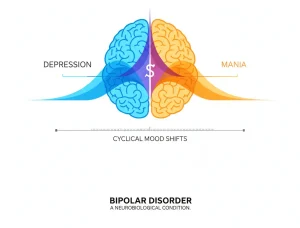Overview
Diagnosis
Bipolar disorder diagnosis involves a detailed evaluation by a healthcare professional to determine the underlying causes of mood changes. Key steps may include:
-
Physical exam: A doctor may perform a physical exam and order lab tests to rule out medical conditions that could mimic bipolar symptoms.
-
Mental health assessment: Referral to a psychiatrist may be recommended. The evaluation covers thoughts, emotions, and behavioral patterns. With permission, family or close friends may provide additional insight.
-
Mood charting: Patients may be asked to record daily moods, sleep patterns, and emotional triggers to help guide diagnosis and treatment.
Diagnosis in Children
Children and teenagers are diagnosed using the same criteria as adults, but symptoms may present differently. Pediatric bipolar disorder often overlaps with other conditions like ADHD or behavioral disorders, complicating diagnosis. A child psychiatrist with experience in bipolar disorder is recommended for accurate evaluation.
Treatment Overview
Bipolar disorder is a lifelong condition, and treatment focuses on stabilizing mood, managing symptoms, and preventing relapse. A healthcare team may include a psychiatrist, psychologist, social worker, or psychiatric nurse.
Treatment options may include:
-
Medications to balance moods.
-
Ongoing treatment to maintain stability.
-
Intensive outpatient programs or partial hospitalization for symptom control.
-
Treatment for substance use disorders, if present.
-
Hospitalization in cases of severe mania, depression, suicidal thoughts, or psychosis.
The main approaches involve medication, psychotherapy, education, and support.
Medications
Medication is essential for controlling mood swings and preventing episodes of mania or depression. Treatment is individualized and may include:
-
Mood stabilizers: Lithium, valproic acid, divalproex sodium, carbamazepine, and lamotrigine.
-
Antipsychotics: Olanzapine, risperidone, quetiapine, aripiprazole, ziprasidone, lurasidone, asenapine, lumateperone, and cariprazine.
-
Antidepressants: Used cautiously and usually combined with a mood stabilizer to avoid triggering mania.
-
Combination therapy: Medications such as Symbyax combine antidepressant and antipsychotic effects for bipolar depression.
-
Antianxiety medications: Benzodiazepines may be used short-term to reduce anxiety and improve sleep.
Finding the right medication often requires trial and error, careful monitoring, and occasional blood tests. Dose adjustments are common as symptoms evolve.
Side Effects and Safety
Side effects can occur and may improve as the body adjusts. Never change or stop medication without consulting your healthcare provider, as this can trigger relapse, withdrawal, or severe mood episodes.
Medicines and Pregnancy
Some medications may cause birth defects or affect breastfeeding. Valproic acid and divalproex sodium should be avoided during pregnancy. Carbamazepine may reduce birth control effectiveness. Discuss treatment options with your healthcare provider before or during pregnancy.
Talk Therapy
Psychotherapy is a key component of treatment and can be provided individually, in groups, or with family. Common therapies include:
-
Interpersonal and social rhythm therapy: Helps establish consistent daily routines for sleep, diet, and activity.
-
Cognitive behavioral therapy (CBT): Identifies negative thought patterns and teaches coping strategies.
-
Psychoeducation: Educates patients and families about bipolar disorder, warning signs, and relapse prevention.
-
Family-focused therapy: Improves family communication and support for better symptom management.
Other Treatment Options
Additional treatments may be considered for resistant or severe cases:
-
Electroconvulsive therapy (ECT): Brief, controlled seizures alter brain chemistry to relieve symptoms.
-
Repetitive transcranial magnetic stimulation (rTMS): Magnetic waves stimulate brain areas linked to depression.
-
Ketamine therapy: May offer short-term relief from depression and suicidal thoughts, though long-term effects are still under study.
Treatment for Children and Teenagers
Treatment for younger patients is personalized based on symptoms and medication response:
-
Medications: Often the same classes as adults, with careful monitoring for side effects.
-
Talk therapy: Helps children manage routines, cope with stress, address learning challenges, and improve social and family relationships.
-
Psychoeducation: Teaches children and families about bipolar disorder, symptom recognition, and relapse prevention.
-
Support systems: Schools, counselors, and family provide structure and encouragement for optimal outcomes.
Advertisement

